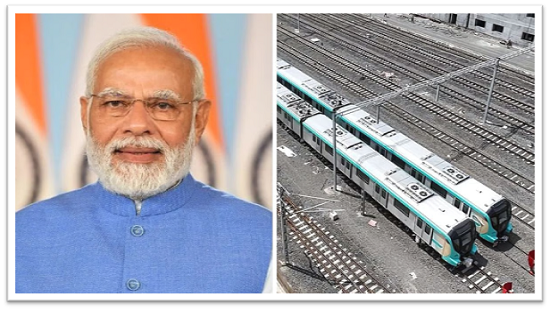
Mumbai Metro 3 Phase 2B Inauguration Today: PM Modi to Open Final Stretch from Worli to Cuffe Parade
Mumbai’s long-awaited urban mobility upgrade reaches a defining milestone today as Prime Minister Narendra Modi inaugurates the final segment of the Mumbai Metro Line 3 (Aqua Line) — a fully underground mass transit corridor that is set to transform North-South connectivity in one of the world’s most congested cities.
The segment being inaugurated is Phase 2B, a 10.99-kilometre stretch from Worli (Acharya Atre Chowk) to Cuffe Parade, completing the 33.5-kilometre line that now runs seamlessly from Aarey in the north to Cuffe Parade at the city’s southernmost tip. This event marks the operational readiness of Mumbai’s first fully underground metro line, a project that has been years in the making, built at a cost of ₹37,276 crore.
A Game-Changer for Urban Mobility in Mumbai
When passenger operations begin tomorrow, October 9, 2025, commuters will for the first time experience uninterrupted, high-speed metro connectivity between the northern suburbs and South Mumbai’s dense commercial and residential districts. This is not just a transport project — it’s a redefinition of commuting in India’s financial capital.
According to officials from the Mumbai Metro Rail Corporation (MMRC), the end-to-end journey from Aarey to Cuffe Parade will take approximately 54 minutes — a dramatic improvement from the 90 to 120 minutes often required by road or suburban rail, particularly during peak hours.
11 New Underground Stations Connecting Key City Zones
The newly opened stretch introduces 11 underground stations strategically located to maximize connectivity across economic, heritage, and residential clusters. These include:
Mahalaxmi, Mumbai Central, Grant Road, Girgaon, CSMT Metro, Marine Lines, Churchgate, and the southern terminal at Cuffe Parade.
This section weaves through some of the most critical and congested corridors of the city, offering an alternative to the overcrowded Western Railway and Central Railway suburban networks. It is expected to significantly reduce the load on Mumbai’s overburdened local trains, which carry over 8 million passengers daily.
Modern Infrastructure with Metro Efficiency
The Aqua Line has been developed with a strong focus on operational efficiency, rider comfort, and system reliability. The fully underground design minimizes land acquisition, preserves surface space, and ensures smooth travel even during monsoon disruptions — a recurring issue for the city’s existing rail and road networks.
Train services will begin daily at 5:55 AM from both ends — Aarey and Cuffe Parade — with the last trains departing at 10:30 PM and terminating by 11:25 PM. These timings are designed to align with the city’s commuter pulse, supporting office-goers, students, and late-evening travellers alike.
Fare Structure Designed for Affordability
The Metro 3 fare model follows a distance-based structure, ranging from ₹10 to ₹70 for the full route. This pricing is aimed at ensuring affordability while sustaining long-term operations and maintenance. Compared to the escalating costs of fuel and private mobility, the Aqua Line offers a cleaner, faster, and cost-effective alternative for daily commuters.
Completing the Vision: From Fragmented Transit to Integrated Mobility
With this final stretch in place, Mumbai Metro Line 3 now forms a complete North-South backbone for the city’s mass rapid transit system. For decades, South Mumbai — home to key institutions, commercial districts, courts, ports, and historic precincts — has remained under-served by metro connectivity. The Aqua Line now integrates these zones into the broader metro network, setting the stage for true multimodal commuting when linked with upcoming lines and interchanges.
Beyond easing congestion, the metro is expected to deliver significant environmental dividends, cutting an estimated 2.6 lakh tonnes of CO₂ emissions annually and reducing thousands of car journeys each day. Its full electrification and energy-efficient systems align with Mumbai’s broader urban sustainability goals.
Strategic Infrastructure, Long-Term Returns
Developed over several years and built with international tunnelling technology under complex geological conditions, the ₹37,276 crore project is among the most ambitious public transport initiatives in Indian urban history. While the financial investment is substantial, the projected long-term returns — in time saved, pollution reduced, productivity enhanced, and economic activity unlocked — far outweigh the costs.
According to the Mumbai Metropolitan Region Development Authority (MMRDA), the line is projected to serve over 17 lakh passengers daily in the coming years, making it one of the busiest metro corridors in the country.
A Turning Point for Commuters and the City
The completion of Mumbai Metro Line 3 comes at a time when India’s urban centres are under increasing pressure to balance growth with livability. With work-life distances growing and roads clogged with private vehicles, metro systems offer a scalable, sustainable solution. For Mumbai — a city that lives on movement — the Aqua Line is more than infrastructure; it is freedom, efficiency, and future-readiness.
As the final stretch from Worli to Cuffe Parade opens today, Mumbai moves a step closer to becoming a city where mass transit is not an afterthought, but the mainstay of urban design.
Tomorrow, as the first passengers ride the full length of the Aqua Line, they won’t just be travelling across the city — they’ll be experiencing what a modern, efficient, people-first Mumbai could look like.





